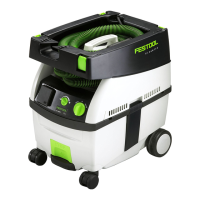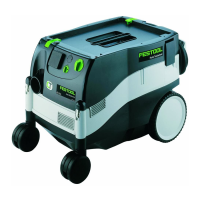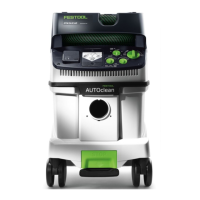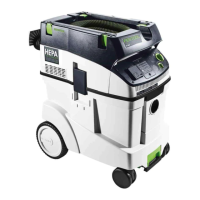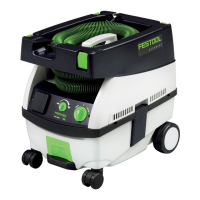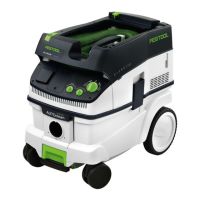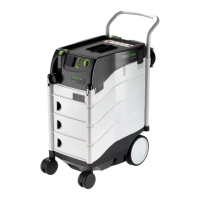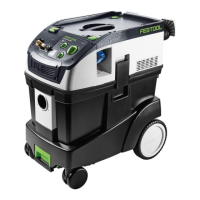Supplemental Owner’s Manual 5
conditions and the work to be performed. Use of the power
tool for operations different from those intended could result
in a hazardous situation.
► To reduce the risk of serious injury, never alter or misuse the
power tool.
Service
►
using only identical replacement parts. This will ensure that
the safety of the power tool is maintained.
Specic Safety Rules for Dust Extractors
► The dust extractor uses a 3-prong grounded plug. Never
connect the dust extractor to an ungrounded electrical outlet.
Never defeat or bypass the ground prong. Do not use the
dust extractor if the ground prong is broken or missing.
► Take care when using the dust extractor on stairs or elevated
work areas.
► Do not vacuum toxic, carcinogenic, combustible or other
hazardous materials such as asbestos, arsenic, barium, beryl-
lium, lead, pesticides or other health endangering materials.
► Do not pick up anything that is burning, smoldering, or smok-
ing, such as cigarettes, matches or hot ashes.
►
as gasoline, or use in areas where they may be present.
►
dust may become explosive. Do not throw sanding dust on an
Respiratory Exposure Safety Warnings
Substantial or repeated inhalation of dust and other airborne
contaminants, in particular those with a smaller particle size,
by power sanding, sawing, grinding, drilling and other construc-
tion activities contain chemicals or substances known (to the
State of California and others) to cause cancer, birth defects or
other reproductive harm. Some examples of these chemicals/
substances are: lead from lead-based paints; crystalline silica
from bricks, cement, and other masonry products; arsenic and
chromium from chemically-treated lumber; and some wood
dusts, especially from hardwoods, but also from some soft-
woods such as Western Red Cedar.
The risk from these exposures varies, depending on how often
you do this type of work. To reduce your exposure to these
chemicals: work in a well ventilated area and use a properly
functioning dust extraction system. When the inhalation of
dust cannot be substantially controlled, i.e., kept at or near the
ambient (background) level, the operator and any bystanders
dust encountered.
Dust Extractor Overview
Intended Use
The dust extractor is designed for use for the suction and
evacuation of non-noxious dusts, dirt, sand, shavings etc.,
for vacuuming water. The dust extractor is designed for both
household and commercial use, and for both workshop and
household applications.
The dust extractor should not be altered or used for any
instructions. Using the tool in contravention to this manual
will void your warranty and may lead to injury. The user
shall be responsible and liable for damages and accidents
resulting from misuse or abuse of this dust extractor.
Technical Specications
CT Mini CT Midi CT 26 E CT 36 E CT 36 AC CT 48 E
Power Consumption 400-1200 W 350-1200 W
Max Connected Load 1200 W
Maximum Air Flow
24 kPa (3.48 psi)
Sound
Filter Surface
Dimensions:
L x W x H
mm / inch
430 x 330 x 420
430 x 330 x 470
x x 540
24.8
x 14.4 x 21.3
x x
24.8
x 14.4 x 23.5
x x
24.8
x 14.4 x 23.5
740
x x 1005
x x
Weight
15.2 kg (33.5 lb)
Collection Capacity 48 L (12.7 gal)
These specications are subject to change without notice.
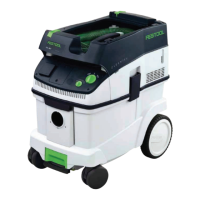
